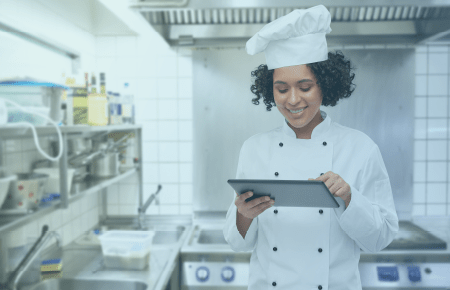Hospitality organizations that implement connected kitchen technologies benefit from improvements such as:
- Real-time visibility and insights into kitchen and equipment operations.
- Better equipment performance and potentially longer equipment lifespans by being able to predict, rather than react to, service needs.
- Lower energy expenses by using consistent, efficient equipment, and having the ability to control appliances remotely.
- Optimize maintenance schedules by having a better understanding of service requirements.
- Minimizing staff effort to operate appliances by leveraging automated processes.
“Smart kitchens, which use some combination of automation, customer geolocation and predictive analytics, are streamlining food preparation processes,” according to Publicis Sapient, a digital business transformation company. “These kitchens are designed to improve speed of service, food quality and order accuracy and many are also testing technologies like IoT [internet of things] devices, sensors, cameras, voice recognition and robotics.”
Appliances in a connected kitchen can be controlled remotely, and they offer advanced precision controls and safety features to lower overhead costs and reduce accidents. Connected kitchens can benefit all facets of the hospitality industry, including:
- Restaurants
- Commercial food services
- Food commissaries
- Production kitchens
- Ghost kitchens
- Incubator kitchens
- Commercial kitchens
- College and university kitchens
- Business and industry kitchens
A FAST-GROWING SMART KITCHEN MARKET
The smart kitchen appliance market is predicted to reach $60.19 billion in 2030, up from an estimated $18.75 billion in 2023, according to Grand View Research. This represents a compound annual growth rate (CAGR) of 18.4%. The market includes smart appliances for residential use, too.
“From large to small appliances, smart gadgets are enabling device-to-device and cloud-to-cloud connectivity, providing a simpler and more seamless user experience by integrating all products from various manufacturers and unlocking certain functionalities,” the research company explains. “For instance, the base model of a modern smart fridge incorporates smartphone connectivity for remote temperature management and notifications in case of unexpected temperature fluctuations.”
Smart refrigerators are the top selling smart appliance, grabbing about 33% of the market in 2022. Spending on smart cookware and cooktops is projected to see a significant 19.4% CAGR from now until 2030.
An increase in consumers dining out “has encouraged restaurant owners to invest in advanced and efficient kitchen appliances that can produce good quality and tasty food much faster, thereby boosting the uptake of smart kitchen appliances in the commercial sector,” according to Grand View Research. “Appliances like grillers, fryers, ovens and cooktops are being used more frequently as they improve preparation consistency, diminish human dependence and reduce human error.”





